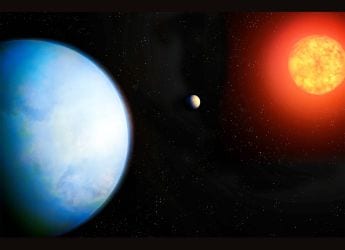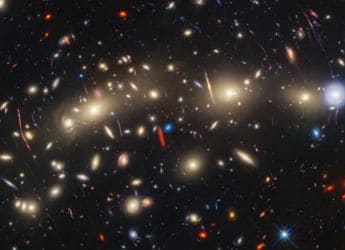- Home
- Science
- Science News
- James Webb Telescope May Have Spotted First Generation of Stars in the Universe
James Webb Telescope May Have Spotted First Generation of Stars in the Universe
JWST observations suggest Population III stars may have formed 13 billion years ago, helping trace early galaxies.

Photo Credit: NASA, ESA, CSA, STScI, Jose Diego (IFCA), Jordan D'Silva (UWA), Anton Koekemoer (STScI)
Population III stars, the first generation of stars, in distant LAP1-B cluster
Astronomers might have spotted the first stars of the universe, called Population III stars, orbiting 13 billion light-years away in a distant cluster known as LAP1-B using the James Webb Space Telescope (JWST). Those primordial stars, believed to have arisen shortly after the Big Bang, might be a million times heavier than the sun, and they lit up a billion times as bright. We might learn important lessons from them about the birth of the earliest galaxies, how hydrogen and helium turned into dark matter, with metals later fanning everywhere across the cosmos.
James Webb Telescope Detects Possible Population III Stars, Illuminating Early Galaxy Formation
According to a report in The Astrophysical Journal Letters, the team employed JWST's infrared features and the gravitational lensing of the foreground galaxy cluster MACS J0416, which magnified the light from LAP1-B, enabling them to observe the ancient stars. Spectral analysis revealed emission lines indicating a population of very-high-energy photons, and the estimated masses of the stars fit what theoretical models suggest for Population III members.
Population III stars were born in small, low-metallicity clusters hosting only a few massive stars, and provide clues to the early galaxy formation and metal enrichment of primordial gas. These stars might be building blocks for larger galaxies as well, making it possible for astronomers to know more about the structure and evolution of the universe's first cosmic systems.
JWST's 6.5-meter mirror scooped up stretched infrared light from faint early stars, employed sophisticated instruments, and took advantage of gravitational lensing to put theories about the cosmic formation that date back decades to the test.
If confirmed, the detection reveals the first glimpse of pristine Population III stars and could help trace early galaxy formation, as well as our universe's first billion years, lead author Eli Visbal mentioned.
Get your daily dose of tech news, reviews, and insights, in under 80 characters on Gadgets 360 Turbo. Connect with fellow tech lovers on our Forum. Follow us on X, Facebook, WhatsApp, Threads and Google News for instant updates. Catch all the action on our YouTube channel.
Related Stories
- Samsung Galaxy Unpacked 2025
- ChatGPT
- Redmi Note 14 Pro+
- iPhone 16
- Apple Vision Pro
- Oneplus 12
- OnePlus Nord CE 3 Lite 5G
- iPhone 13
- Xiaomi 14 Pro
- Oppo Find N3
- Tecno Spark Go (2023)
- Realme V30
- Best Phones Under 25000
- Samsung Galaxy S24 Series
- Cryptocurrency
- iQoo 12
- Samsung Galaxy S24 Ultra
- Giottus
- Samsung Galaxy Z Flip 5
- Apple 'Scary Fast'
- Housefull 5
- GoPro Hero 12 Black Review
- Invincible Season 2
- JioGlass
- HD Ready TV
- Laptop Under 50000
- Smartwatch Under 10000
- Latest Mobile Phones
- Compare Phones
- Vivo Y500 Pro
- Realme GT 8 Pro Aston Martin F1 Limited Edition
- Huawei Mate 70 Air
- Moto G57
- Moto G57 Power
- Motorola Edge 70
- Moto G Play (2026)
- Moto G (2026)
- MacBook Pro 14-inch (M5, 2025)
- Asus Vivobook S16 (S3607QA)
- iQOO Pad 5e
- OPPO Pad 5
- Noise Diva 2
- Noise Halo 2
- Acerpure Nitro Z Series 100-inch QLED TV
- Samsung 43 Inch LED Ultra HD (4K) Smart TV (UA43UE81AFULXL)
- Asus ROG Ally
- Nintendo Switch Lite
- Haier 1.6 Ton 5 Star Inverter Split AC (HSU19G-MZAID5BN-INV)
- Haier 1.6 Ton 5 Star Inverter Split AC (HSU19G-MZAIM5BN-INV)

















